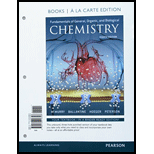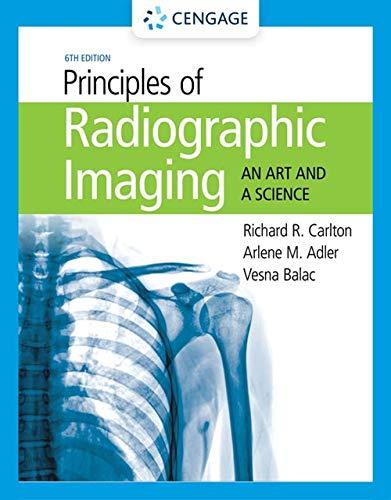
Hydrogen fluoride is one of the few substances that react with glass (which is made silicon dioxide. SiO2).
(a) How many moles of HF will react completely with 9.90 mol of SiO2?
(b) What mass of water (in grams) is produced by the reaction of 23.0 g of SiO2?
Want to see the full answer?
Check out a sample textbook solution
Chapter 6 Solutions
Fundamentals of General, Organic, and Biological Chemistry, Books a la Carte Edition; Modified Mastering Chemistry with Pearson eText -- ValuePack ... and Biological Chemistry (4th Edition)
- please help and explair you'd count the disulfide bonds caused by the cystines and include the n and c terminusarrow_forwardc. C₂H₂ 'alkyne d. C7H12 alkyne 2. Draw the line-angle formula for the following compounds. a. 4,4-diethyloctane 2 3 7 8 b. 4-ethyl-2,2-dimethylhexanearrow_forwardHenderson Hasselbalch Practice Sheet. 1) Buffered solution 1 has a pH of 8. [A-] = 100 mM, [HA] = 10 mM. Solve for pKa of this acid. 2) A phosphate buffer (pk2 = 7.2) has molar concentrations of [H2PO4 ] = 100 µM, [HPO42-] = 1 mM. Solve for pH. = 3) When pH 5, the pKa of the acid = 7, and the molar concentration of acid = 100 μM, what is the molar concentration of the base? 3arrow_forward
- 7. Which one is the major organic product obtained from the following reaction? CHO COOH CH₂OH CHO COOH H- -OH H₂ H- OH H- -OH H- -OH Ni HO -H HO -H HO- -H HO- H HO- H H- -OH H- -OH H- -OH H -OH H- -OH H- -OH H- -OH H- -OH H- -OH H -OH CH₂OH CH₂OH CH₂OH CH₂OH COOH A B C Darrow_forward4. The compound on the right is- B) a ketopentose C) an aldohexose A) an aldopentose D) a ketohexose E) a ketoheptose OH OH CH2OH OHarrow_forward12. When glutamic acid is heated to 180°C., it loses a molecule of water to form a lactam. The bond that creates the lactam is an amide bond that forms between the amino nitrogen and the carbon of the side chain -COOH group. What is the most reasonable structure for this lactam? (NOTE: The structure of glutamic acid is shown in Question 1.) COOH COOH ا کچھ جو کچھ C D COOH B COOH E COOHarrow_forward
- 10. Which one of the following compounds is the major organic product of the series of reactions shown here? Ph A OH Ph B CO₂Et Br -H Ν ΚΑ CO₂Et 1. NaOEt 1. NaOH, H₂O 2. H3O+ 2. PhCH2CH2Br 3. heat NH2 Ph OH NH2 0 OH Ph OH NH2 Ph D NH2 E OHarrow_forward1. What is the isoelectric point of glutamic acid? (Glutamic acid has pKa1 2.10, pKa2 4.07, pKaз 9.47) A) pH 2.1 D) pH 6.8 B) pH 3.1 C) pH 4.1 E) pH 9.5 HO NH2 Glutamic acid (shown without charges) OHarrow_forwardBr Mg, ether 1. HCHO (formaldehyde) 2. H+, H₂O PCC 1. NH3, HCN ? (pyridinium chlorochromate) 2. H2O, HCI 11. Which one of the following compounds is the major organic product of the series of reactions shown above? Ph. Ph. OH NH2₂ A Ph. Ή NH2 B OH Ph Η Ph OH NH2 NH2₂ NH₂ C D Earrow_forward
- B A 6. Which ONE of the labeled bonds in the tripeptide on the right is a peptide bond: H₂N N 'N' OH C H A, B, C, D or E? HN E OHarrow_forwardQuestions 8-9 are 0.4 points each. The next two questions relate to the peptide whose structure is shown here. To answer these questions, you should look at a table of H2N/.. amino acid structures. You don't have to memorize the structures of the amino acids. IZ 8. What is the N-terminal amino acid of this peptide? A) proline B) aspartic acid C) threonine 9. What is the C-terminal amino acid of this peptide? A) proline B) aspartic acid C) threonine N OH D) valine E) leucine D) valine E) leucine NH "OH OHarrow_forward7. What is the correct name of the following tripeptide? A) Ile-Met-Ser B) Leu-Cys-Thr C) Val-Cys-Ser D) Ser-Cys-Leu E) Leu-Cys-Ser H₂N!!!!! N H ΖΙ .SH SF H IN OH OHarrow_forward

 Principles Of Radiographic Imaging: An Art And A ...Health & NutritionISBN:9781337711067Author:Richard R. Carlton, Arlene M. Adler, Vesna BalacPublisher:Cengage Learning
Principles Of Radiographic Imaging: An Art And A ...Health & NutritionISBN:9781337711067Author:Richard R. Carlton, Arlene M. Adler, Vesna BalacPublisher:Cengage Learning Biology (MindTap Course List)BiologyISBN:9781337392938Author:Eldra Solomon, Charles Martin, Diana W. Martin, Linda R. BergPublisher:Cengage Learning
Biology (MindTap Course List)BiologyISBN:9781337392938Author:Eldra Solomon, Charles Martin, Diana W. Martin, Linda R. BergPublisher:Cengage Learning





